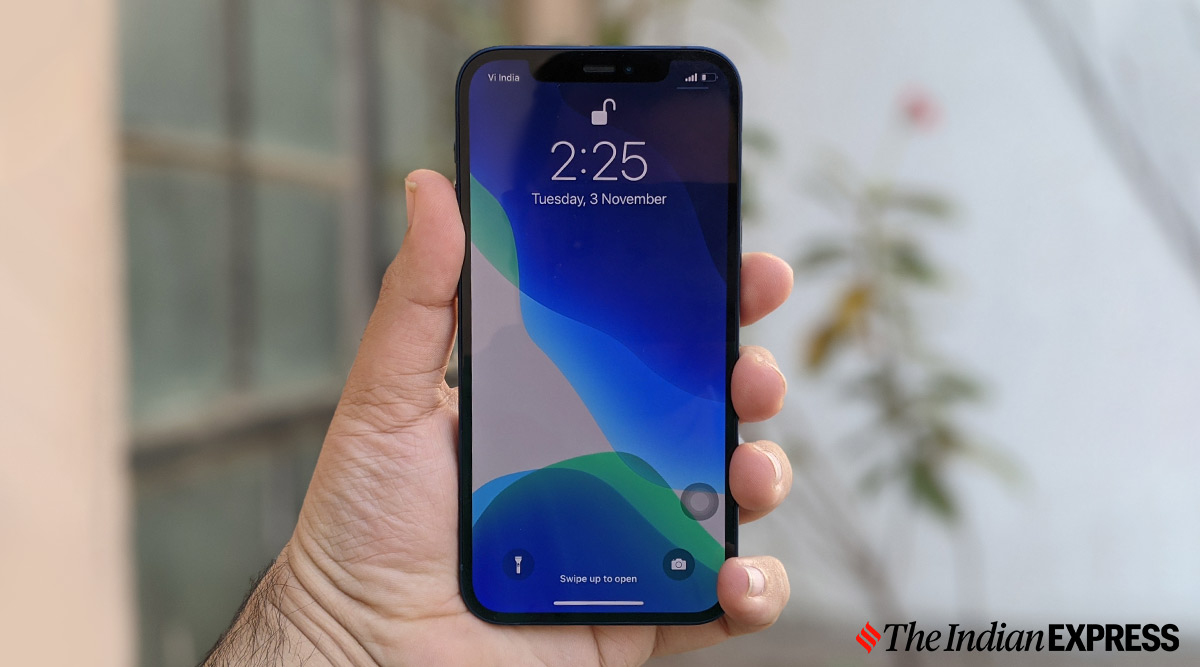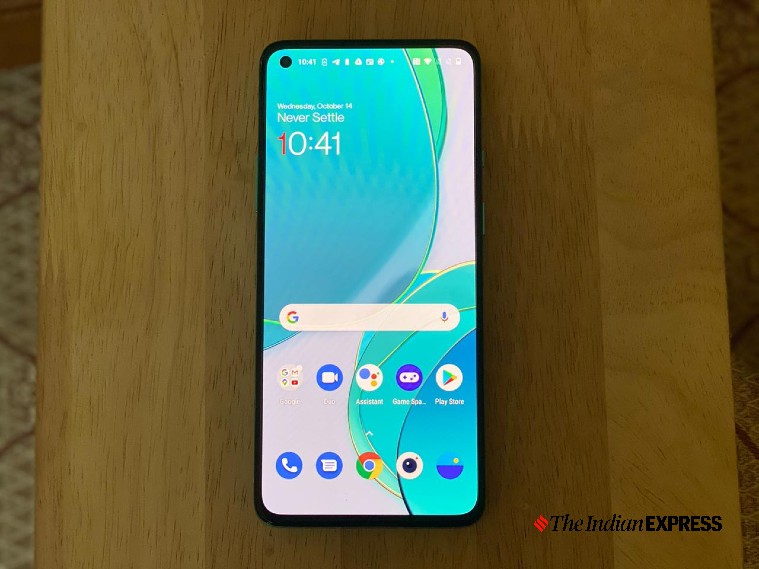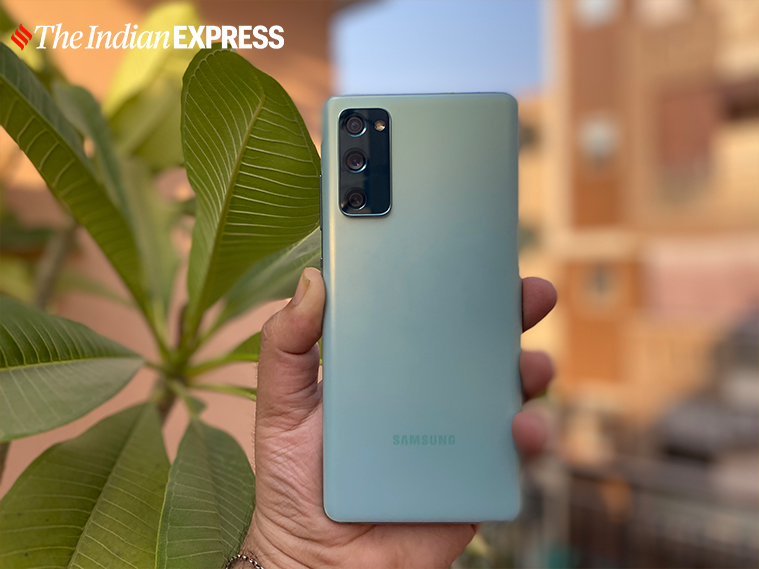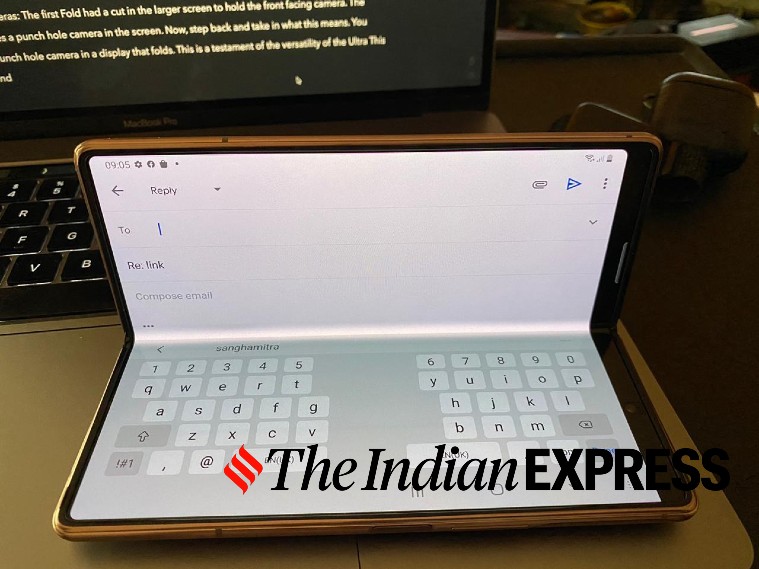 The iPhone 12 is one the best smartphones of 2020. (Image credit: Anuj Bhatia/Indian Express)
The iPhone 12 is one the best smartphones of 2020. (Image credit: Anuj Bhatia/Indian Express) It was quite an eventful year for the premium smartphone market. This year, some of the biggest names in the smartphone business released phones that resonated with people across demographics. Apple, Samsung and OnePlus continued to impress with their smartphone lineup. For a change, though, Xiaomi too did the same with its flagship lineup in what can be seen as a sign of its intentions in the high-end smartphone market.
While choosing the best premium smartphones of the year, we not only looked at the design and screen quality, but also speed, cameras, and special features these devices had to offer.
Apple iPhone 12
It wouldn’t be wrong to call the iPhone 12 the most “complete” smartphone of the year. While it wasn’t a revolutionary smartphone, despite that, the iPhone 12 impressed us for its simplicity and sheer brilliance. Why the iPhone 12 worked in the first place was because of the straightforward messaging. Throughout the ad campaigns, Apple clearly made emphasis on highlighting what the iPhone 12 stood for and focused on the features that really matter to potential customers. That probably helped the iPhone 12 to create a fan base of its own, despite no headline-grabbing features. Read our review of the iPhone 12 here.
 Apple iPhone 12 Pro Max. (Image credit: Nandagopal Rajan/Indian Express)
Apple iPhone 12 Pro Max. (Image credit: Nandagopal Rajan/Indian Express)
Apple iPhone 12 Pro Max
No other premium smartphone this year impressed us more than the iPhone 12 Pro Max. Designed for creators and pro consumers, the iPhone 12 Pro Max represented a giant leap in smartphone photography. Its triple cameras captured more details in low-light, plus the iPhone 12 Pro Max left every other smartphone in dust in video capturing. The iPhone 12 Pro Max wasn’t trying to be a DSLR killer but Apple did prove that its most ambitious smartphone was better at doing certain things professional cameras can’t. In a way, Apple’s most accomplished smartphone brought certain elements in photography space that pro photographers had always wished for in the iPhone. Read our review of the iPhone 12 Pro Max here.
 Samsung Galaxy Note 20 Ultra. (Image credit: Nandagopal Rajan/Indian Express)
Samsung Galaxy Note 20 Ultra. (Image credit: Nandagopal Rajan/Indian Express)
Samsung Galaxy Note 20 Ultra
Despite its uncanny resemblance to the Galaxy S20 Ultra, the Note 20 Ultra held its place in 2020. The Note 20 Ultra was a heck of a device, perhaps the most powerful Android smartphone we saw this year. The Note 20 Ultra offered everything business customers would ask for in a premium smartphone: a gigantic screen, long battery life, a fantastic S Pen, top-notch connectivity, and excellent performance. The only real shortcoming the Galaxy Note 20 Ultra suffered from was that it didn’t bring anything new to the table. Maybe Samsung should bring some features of the Galaxy Note series to the S series and increase the demography of the Note brand. Read our review of the Galaxy Note 20 Ultra here.
 OnePlus 8T. (Image credit: Nandagopal Rajan/Indian Express)
OnePlus 8T. (Image credit: Nandagopal Rajan/Indian Express)
OnePlus 8T
The OnePlus 8T was neither innovative nor fresh in its approach, yet it somehow was able to match the expectation of consumers. Well, the approach was simple: create a premium smartphone with the best specs possible. The phone had a higher 120Hz refresh rate display, a bigger 4,500mAh battery, quicker 65W fast charging, and an extra camera. Specs do matter, but the OnePlus 8T was indeed a better phone than the OnePlus 8 Pro. Combined with the price and the all-around performance, the OnePlus 8T delivered a high-end smartphone experience that appealed to consumers. Read our review of the OnePlus 8T here.
 Samsung Galaxy S20 FE. (Image credit: Anuj Bhatia/Indian Express)
Samsung Galaxy S20 FE. (Image credit: Anuj Bhatia/Indian Express)
Samsung Galaxy S20 FE
Call it the highest-rated Android smartphone or one of the best Android phones of 2020, the Galaxy S20 FE (Fan Edition) emerged as the compelling alternative to the OnePlus 8T. Although many raised doubts about the Galaxy S20 FE initially, Samsung managed to produce a phone that offered comparable features to flagship smartphones at a lower price. It’s got a big 120Hz display, fast Exynos processor, large capacity 4500mAh battery, IP68 dust/water resistance, and three rear cameras. Yes, it’s made out of less expensive materials, but it didn’t have any impact on the performance of the smartphone. Read our review of the Galaxy S20 FE here.
 Xiaomi Mi 10T Pro. (Image credit: Anuj Bhatia/Indian Express)
Xiaomi Mi 10T Pro. (Image credit: Anuj Bhatia/Indian Express)
Honorable mentions
Mi 10T Pro
The Mi 10T Pro was a revelation. It had all the bells and whistles one could ever want in a high-end Android smartphone. The screen had a 144Hz refresh rate, the processor was the fastest in its class, it supported 5G, and had the comparable build quality of any Android flagship that came out this year. It even included a 108MP camera. It’s a pity that the Mi 10T Pro didn’t get the respect it deserved. Read our review of the Mi 10T Pro here.
 Samsung Galaxy Z Fold 2. (Image credit: Nandagopal Rajan/Indian Express)
Samsung Galaxy Z Fold 2. (Image credit: Nandagopal Rajan/Indian Express)
Galaxy Z Fold 2
The Galaxy Z Fold 2 was an absolute luxury smartphone, and much of its credit goes to the foldable phone status. It wasn’t an ordinary phone — it’s made for people who buy Louis Vuitton bags or luxury watches. The flag-bearer of folding phones was an exciting device but that doesn’t mean it’s worth buying right now. There’s still a lot of durability questions over its foldable screen, plus the cost of ownership is way too high. That said, the Galaxy Z Fold 2 could be the device we all will be using in the future. Read our first impressions of the Galaxy Z Fold 2 here.